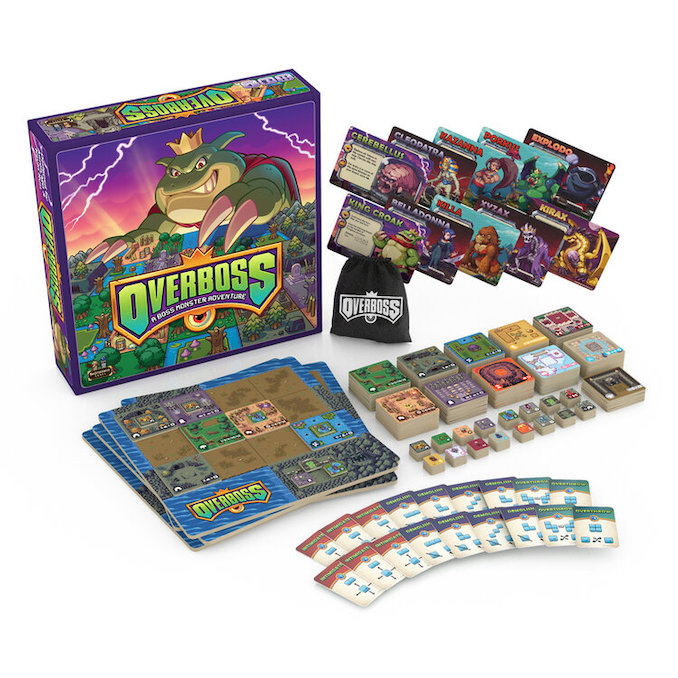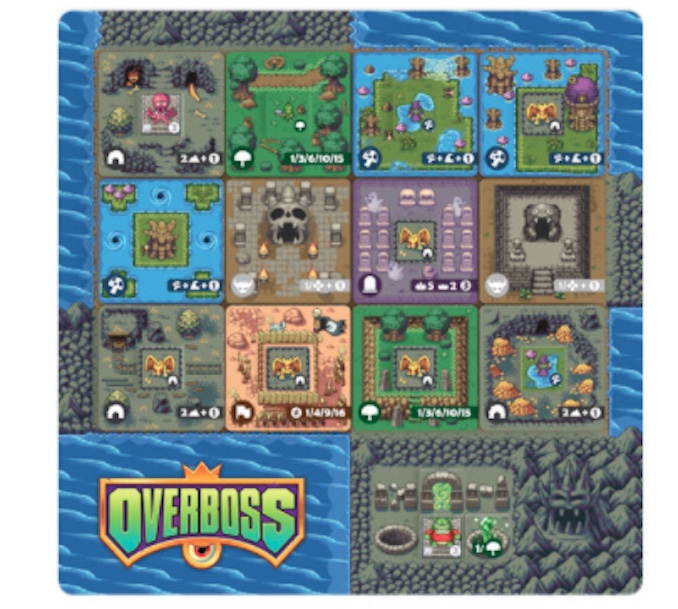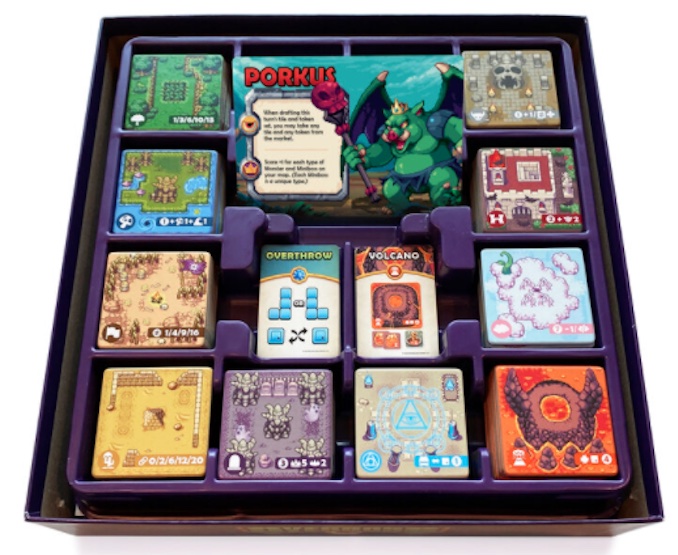Our review of Overboss: A Boss Monster Adventure, designed by Aaron Mesburne and Kevin Russ, published by Brotherwise Games. Available now.

WHAT IS IT?
A fun riff on the tile-matching genre with a very light thematic coat.
IS IT GOOD?
It works best as a short apéritif before diving into some other, longer game and/or the core Boss Monster experience.
WHO SHOULD PLAY IT?
Moss Bonsters.

LINK TO THE PAST
Since its 2013 debut, the Boss Monster series has quietly, steadily built itself an audience of only the most discerning nerds. A “board game dungeon crawler”, Boss Monster casts players as video game-style bosses under constant attack from “Hero cards.” Players defend with thematic room cards – a bomb factory which explodes upon entry, a room full of “mimic” chests to lure Heroes – which are laid out left to right, like an 8-bit dungeon. Structurally, the game recreates the feel of a video game side scroller, while its hundreds of unique cards offer up amusing pop culture references – that bomb factory above? it’s a winking nod to Super Mario‘s Bob-ombs.
True to its digital inspirations, Boss Monster has been around long enough to inspire a spinoff in an entirely separate genre. Gone is the side-scrolling structure, gone are the heroes. Instead, Overboss brings us a shift in perspective, to a Zelda-style overworld and tile-matching system seemingly borrowed from the SATs. It’s a great deal of fun, it looks great, and though it lacks some of the charm of Boss Monster, it’s a heck of a lot more balanced.

FROM THE CAVES TO THE MOUNTAINTOPS
Overboss is a 1-5 player board game in which each player builds an “overworld” consisting of tiles laid out in a grid. Each player has their own board, where they lay down terrain tiles – forests, swamps, caves, and so on – while also populating the terrain with Monsters and Miniboss tokens. A handful of other tokens – coloured crystals which align to terrain types, teleportation portals which let you swap pieces – shake things up through easily learned gameplay mechanics.
Like other tile-matching games, Overboss is built around “drafting” – each turn, a player selects one terrain tile plus one token to place on their overworld. Points are tallied at the end of the game, once each player’s overworld board is completely filled in.
While terrain and tokens can be played pretty well anywhere, the key to Overboss is careful placement. Swamps, for example, score more points when placed next to bodies of water, while caves do best at the base of a mountain. Some terrain tiles have more complicated point calculations. Desert tiles score highest when they snake across the length of a board, for example.
It’s similar for Monsters: place a Monster token on a thematically appropriate terrain – a skeleton in a graveyard, for example – and you score more points. But you also get points for lining up 2-3 Monsters across adjacent tiles, raising interesting strategic considerations: do you place a skeleton on a castle tile, because there’s a skeleton on the graveyard tile next door? Or do you put a vampire in the castle, since there are bonus points for vampire-castle synergy?
The mathematically minded will find much to contemplate here, though there’s a risk of analysis paralysis for players intent on maximizing points.
There are other, quasi-optional wrinkles. For example, you can assign each player a Boss Monster with a unique game-changing ability. There’s also a stack of optional “Command Cards” which largely function to sabotage other players’ tile layouts. Technically these are optional, though it’s hard to see why you’d exclude them, unless playing with younger gamers.

JEOPARDY!
By far the biggest loss in Overboss‘s transition to the overworld is the absence of pop culture homage. A quick scan through the Boss Monster database and you’ll spot hundreds of loving references, from legendary video game Portal to Werner Herzog collaborator Klaus Kinski to Canada’s own Ramona Flowers and Alex Trebek. Such references are absent from Overboss, by design a more abstract game played quite literally from a bird’s eye view. The only time you’ll spot any familiar faces are on the optional “Boss cards” featuring returning Boss Monsters characters such as the Dungeons & Dragons homage Xyzax or Explodo, a dead ringer for the Kool-Aid Man. It’s disappointing that these are all repeat characters, though. Not only does Overboss lack the thematic humour of Boss Monster, it couldn’t even be bothered to introduce new monsters.
Neither Boss Monster nor Overboss are particularly sophisticated games, but what Boss Monster lacks in balance, it more than makes up for in the charm of each newly revealed card, whether it’s Scott Pilgrim’s girlfriend or a factory full of Bob-ombs with very short fuses. Overboss, on the other hand, is more structurally sound, which makes sense given its co-creator is responsible for the award-winning Calico. Though it may lack Boss Monster‘s pop culture themes, Overboss looks just as lovely, with adorable 8-bit terrain and pixelated monsters. It’s also a lot of fun, with easily understood mechanics and appropriately short play sessions.
I don’t love Overboss in the same way I love Boss Monster, but it has a certain charm to it, and there’s nothing wrong with a decent spinoff game. Just ask Mario Party.
***
Final score: 8/10 kobolds.
Visit the official page for Overboss: A Boss Monster Adventure here.



